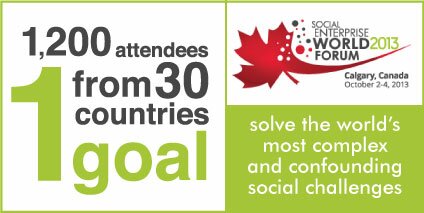The Business of Re-Weaving a Good City
By Milton Friesen, Program Director - Social Cities, Cardus
Milton Friesen will be attending SEWF 2013.
People that enjoyed this article may wish to check out the SEWF 2013 program streams "Social Innovation."
SEWF 2013 is reposting this article as part of an ongoing series of articles by or about SEWF 2013 attendees.
SEWF 2013 has an amazing array of speakers, but we didn’t want the event to be a passive experience of one-way communication. We know our attendees also have powerful insights to share – insights that can inform and inspire others and enhance the evolution of social enterprise and social innovation.
If you are a SEWF 2013 attendee and have created or want to create articles on key ideas, insights or issues relating to social enterprise or social innovation, we would be happy to post them. Please keep in mind that these articles cannot simply be profile pieces – that is what Sched is for.
Send your article to .
The feature picture is courtesy of Compfight / A Flickr Search Tool.
Some say that to further the greater common good, our cities need more—more stadiums, more airport power centres, more public transit.
But what would city building look like if we focused on integration and synthesis, rather than simply defaulting to "more"?
What if we arranged what we have into new combinations? Could that lead to better business? Economic growth? Human flourishing?
More than half the population in North America lives in cities, and our hope for city building must rest in these dwellers. Thoughtful people are looking more closely at the nature of our social networks within cities as a way of understanding how to foster economic development, social care, and community flourishing. Closer examination reveals that many of the ingenuity gaps we face are social.
Humans are highly relational. The nature and strength of our connections with each other powerfully predicts the relative health of our common good—sustained when connections are vital and healthy, but costing us dearly when weak. Our economics, our recreation, our use of technology, even our very identities all depend on our relationships with other people.
The radical growth of social technologies suggests, rather loudly, that technological advances facilitate rather than eradicate that nature.
Much city planning uses lenses that are suspiciously similar to those used to assess bridges, roadways, and other construction projects involving materials, formulas, and methods to also analyze groups of people. But people don't really work the same way as physical infrastructure, despite the many models of human interaction that cast us as one-dimensional economic machine parts. Understanding the role of relationships is a different science, and we need ideas oriented to that difference. This is true even in pro-technology business circles. Henry Ford was famous for noting that even though all he needed was the arm of a man to operate a machine, the rest of him inevitably came with the arm, thus causing complications.
There are many ways to take stock of a city—income, life expectancy, employment rate, post-secondary education, emergency room visits, population, building densities, population densities, commercial activity, building permits issued, food bank usage, social agency statistics, and so on. When we analyze our cities through one of these lenses, we see solutions aligned with the analysis. If we measure health, we see the need for health solutions; if we measure commercial activity, we see what needs to change in the commercial activity of the city; if we are educators, both the problems and solutions are related to education.
But when these ways of measuring are themselves part of the cause, the solutions based on them often fail to accomplish the ends we desire.
In truth, the social weaving and re-weaving of the city resists singular solutions. Our human communities—full of technological accelerations, impairments, enhancements, and disfigurations—just don't run on linear tracks. We are emerging from an era hell-bent on linear control and reductive analysis, which says that you know a thing if you can see the constituent pieces, and knowing that, you can make it behave just the way you want. We have been much less skilled in understanding the relationships among composite issues and challenges. This shows up in archaic and broken corporate cultures, educational paralysis, and awkward civil service moves.
When our efforts to help come from the top and are out of touch with the ground-level conditions of life, we run the risk of paternalistic largesse made manifest through imported and ill-suited solutions. The result? Deep disconnect from local realities, low adoption rates for new programs, and significant waste.
A better way of examining collective well-being is emerging from social network research. Social network theory explores the shape, dynamics, and results of our individual and collective relationships.
Understanding social networks aligns well with other more hopeful urban design ideas and practices.
We are slowly learning that social networks in cities need permeable, brokering institutions that facilitate relationships and the exchange of ideas and resources that occur in those relational interactions. They don't need a single kind of institution; instead, they require a plurality of diverse and changing structures that enable the pursuit of flourishing—a kind of skilful living that is born of a long and persistent wisdom. Business lives in the midst of human society and is not exempt from this need. Technology doesn't eradicate our need, either, and it cannot be a sufficient substitute, however sophisticated that technology may be.
Building cities based on the research and innovation of social networking will not come easily. I conclude by considering three major tensions in our re-weaving work:
Practicality vs. Innovation. Highly effective social networks function as both exploratory channels for new ideas and innovation and as spaces for consolidation, where resources collect and decisions about those resources are made. In these different functions, we see a living, cooperative tension between the creative and novel, which often live on the margins, and the operational core, where activity is more standard. If there is no core, the novel information on the periphery never turns into anything. If the core is too insulated from innovation, very little new information enters the network and stagnation is inevitable. The economic development story of the ACEnet work in Appalachian Ohio reflects a keen understanding of how this network-weaving can function in very practical ways.
Their approach to local specialty food production invited residents, small business owners, and people on the ground to establish resilient companies and related support networks that could grow and evolve over time without becoming fully centralized—and the initiative's success is instructive.
Growth is much more about creating the right conditions and getting the right balance of openness and direction.
Control vs. Freedom. There is a much wider societal tension between the industrial information economies grown over the last 150 years and the emerging network information economies that are increasingly common today. The former emphasized central control, exclusive rights, enormous capital, and infrastructure investments by the few for careful consumption by the many. Today, ubiquitous computing networks, software, and human interactions that form around these technologies facilitate more widely distributed networks of production, co-creation, and continuous modification. Yochai Benkler (The Wealth of Networks) has been rigourously exploring the nature of this tension and suggests that
it is a deep and fundamental shift that allows for a more free and equitable society, depending on what we do with our laws, practices, and permissions in the coming decades.
We may make decisions that will perpetuate the industrial information economy, where a few control the many, exchanging the old tyrannies for digital versions of the same. But current digital technologies provide a chance to choose another form of life together. Cities will figure heavily in the re-weaving of our intellectual capital that, in turn, shapes our other forms of capital.
Virtual vs. Physical. Our shift to a much more digital and electronic world gives rise to a perpetual, complex dance between the virtual world (of data) and the physical world (of our roads, buildings, and machines). Current research on trends in global urbanization suggests that computing power hasn't made physical building irrelevant—perhaps quite the opposite. The human race consumes and builds with dizzying speed, expanding at rates that would have been unimaginable in centuries past. We will need astronomical amounts of concrete, steel, asphalt, glass, wood, water, and oil to meet the incessant demands of growing populations of city dwellers.
This demand will grow along with increasingly nimble, extensive, and adaptive digital ecologies, a global nervous system that links ideas and impulses with a material world that changes and responds to our intentions and actions.
These are the conditions under which our city-building is taking place. Some of the things we weave are new; others are ancient but are finding new forms, new arrangements that both inspire and alarm. Gaining perspective about these tensions will be critical to intelligent business, technological, and social growth.
More about Milton Friesen:
 Program Director - Social Cities, Cardus
Program Director - Social Cities, Cardus
Key Themes:
Adaptive Design
Complexity Science
Network Science
Urban Planning and Social Innovation
Core ideas that orient a significant amount of my work include the exploration of complexity science by means of various network approaches. Network dynamics are a persistent feature of our human interactions including the organizations, institutions and societies that Cardus is working to support and make sense of.
I am very interested in how organizations adapt to change (or fail to adapt) including the cities where most of the global population lives. Resilient enterprises at all scales invest energy in designing and nurturing intelligent processes that allow room for surprise, novelty and feedback signals.






